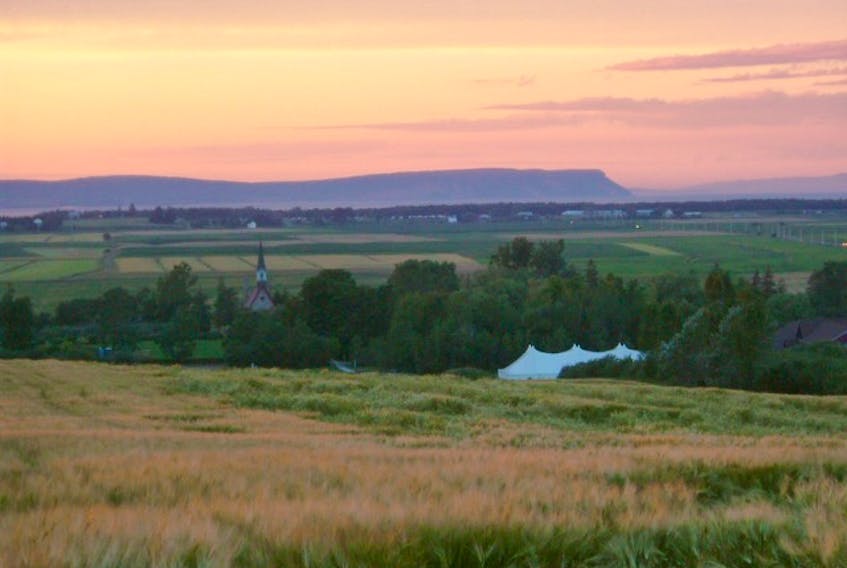There are so many unique relationships that people all over the world have with the park at Grand Pré and the dyked land around it. Recently, I got to take part in an interesting public conversation about its meaning.
In a tent outside the visitor centre, Allan Stewart, who is best known for his Horton Ridge Malt House operation, shared some family history. His ancestor, John McNeil Stewart, settled on lands after the Acadians had been ousted, but only after he endured an unwanted deportation of his own.
Stewart was forced into the British Navy against his will. Eventually, the forced sailor jumped ship to escape. His descendants developed strong ties to the farmlands he settled on.
Allan also described his great grandfather, John Robert Stewart, who took to poetry to cope with homesickness during a stint out west, breaking the prairie soil. His long verses show a distinct awareness of the storied history of Grand Pré.
“The Old Willows are there, They’ve been faithful to mark, The scene of that sorrow, So deep and so dark.”
Thankfully, he did come home, says Allan, and he works the fields here because of that. John Robert’s poem is a testament to his call homeward.
In my experience, Grand Pré is a place of eternal pilgrimage. John Frederic Herbin started the wave over a century ago now. The Dominion Atlantic Railway saw benefits to getting people here, so they maintained the park.
In 1956, when the federal government took over, free entry was guaranteed. Today, the grounds remain free to wander.
I remember back in 1983 when park superintendent Paul Carrier showed me the 1909 Herbin cross rebuilt and noted that, by sheer coincidence, it was evident the site was actually where the village cemetery was located.
Subsequently, it’s marvelous that Dr. Jonathan Fowler has been researching the archaeology of Grand Pré and its surroundings for two decades. Ground Penetrating Radar (GPR) and Electromagnetic Induction are amazing technology for learning more.
In 1992, I recalled the marvelous new superintendent of the day, Barbara LeBlanc, acknowledging that she had not read Longfellow’s famed poem, but before long she could see that the Evangeline myth powers the Acadian identity.
When my daughter sang and danced with Les Enfants de Grand Pré, under LeBlanc’s tutelage, I met an old man in the park. He’d studied the poem Evangeline in a mid west U.S. reader as a child and had always wanted to visit. His was a pilgrimage.
I’m glad now that a developer did not get permission back in the day to create a pseudo Acadian village where visitor centre is now. At the time of the public meeting, Rhoda Colville said, “All my life I’ve thought it was a terrible thing from the English side. We love it, too.”
There were over 400 pilgrims who walked with Jean Gaudet in 2010 for an historic re-enactment of the march the Acadians made on Sept. 5, 1755 from the old church two kilometres east to Horton Landing, where the ships awaited them.
Seven years ago, the landscape of Grand Pré, which includes the historic site, was inscribed on the UNESCO World Heritage list. That act has broadened perspective on the whole area.
Two summers ago, more than 30,000 people celebrated peace and friendship between the Mi’kmaw and the Acadians over four days due to Canada 150. I remember Morley Googoo, regional chief of the Assembly of First Nations for Nova Scotia, Newfoundland and Labrador, saying the event was bringing people together in a calm way, where it was “safe to learn about each other as the two core cultures.”
Last year, Alan Syliboy continued that initiative with a special night of music as his images were projected on the memorial church. Luckily, he will be returning this fall to repeat that unique presentation at the Deep Roots Festival.
Coming up soon is another notable anniversary, Sept. 5 being the day that the village of Grand Pré was broken apart, when the first Acadian families were deported from the shores of the Minas Basin.
Over 30 years ago, a competition was held by Parks Canada to design a stained glass window for the south side of the memorial church. Terry Smith-Lamothe’s winning design interprets the expulsion beautifully. I recommend taking a look at how he created the landscape and added bright red glass.
Every day - and especially on Sept. 5 - splintery red light runs from the window to the front of the church. It lands on the plaque listing the family names of those who were deported. It is a fierce representation of an age-old wrong. Take a look when you can.
Former Advertiser and Register reporter Wendy Elliott lives in Wolfville.









